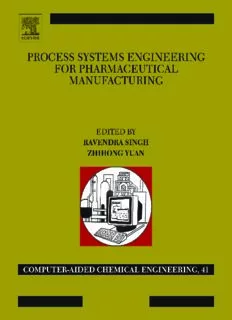
Process Systems Engineering for Pharmaceutical Manufacturing PDF
Preview Process Systems Engineering for Pharmaceutical Manufacturing
Computer Aided Chemical Engineering Process Systems Engineering for Pharmaceutical Manufacturing Volume 41 This page intentionally left blank Computer Aided Chemical Engineering Process Systems Engineering for Pharmaceutical Manufacturing Volume 41 Edited by Ravendra Singh Rutgers, The State University of New Jersey, Piscataway, NJ, United States of America Zhihong Yuan Tsinghua University, Beijing, China Elsevier Radarweg29,POBox211,1000AEAmsterdam,Netherlands TheBoulevard,LangfordLane,Kidlington,OxfordOX51GB,UnitedKingdom 50HampshireStreet,5thFloor,Cambridge,MA02139,UnitedStates Copyright#2018ElsevierB.V.Allrightsreserved. Nopartofthispublicationmaybereproducedortransmittedinanyformorbyanymeans, electronicormechanical,includingphotocopying,recording,oranyinformationstorageand retrievalsystem,withoutpermissioninwritingfromthepublisher.Detailsonhowtoseek permission,furtherinformationaboutthePublisher’spermissionspoliciesandour arrangementswithorganizationssuchastheCopyrightClearanceCenterandtheCopyright LicensingAgency,canbefoundatourwebsite:www.elsevier.com/permissions. Thisbookandtheindividualcontributionscontainedinitareprotectedundercopyrightbythe Publisher(otherthanasmaybenotedherein). Notices Knowledgeandbestpracticeinthisfieldareconstantlychanging.Asnewresearchand experiencebroadenourunderstanding,changesinresearchmethods,professionalpractices,or medicaltreatmentmaybecomenecessary. Practitionersandresearchersmustalwaysrelyontheirownexperienceandknowledgein evaluatingandusinganyinformation,methods,compounds,orexperimentsdescribedherein. Inusingsuchinformationormethodstheyshouldbemindfuloftheirownsafetyandthesafety ofothers,includingpartiesforwhomtheyhaveaprofessionalresponsibility. Tothefullestextentofthelaw,neitherthePublishernortheauthors,contributors,oreditors, assumeanyliabilityforanyinjuryand/ordamagetopersonsorpropertyasamatterofproducts liability,negligenceorotherwise,orfromanyuseoroperationofanymethods,products, instructions,orideascontainedinthematerialherein. LibraryofCongressCataloging-in-PublicationData AcatalogrecordforthisbookisavailablefromtheLibraryofCongress BritishLibraryCataloguing-in-PublicationData AcataloguerecordforthisbookisavailablefromtheBritishLibrary ISBN:978-0-444-63963-9 ISSN:1570-7946 ForinformationonallElsevierpublications visitourwebsiteathttps://www.elsevier.com/books-and-journals Publisher:SusanDennis AcquisitionEditor:KostasKIMarinakis EditorialProjectManager:KarenR.Miller ProductionProjectManager:BharatwajVaratharajan CoverDesigner:GregHarris TypesetbySPiGlobal,India Contents Contributors............................................................................................................xix Preface.................................................................................................................xxiii CHAPTER 1 New Product Development and Supply Chains in the Pharmaceutical Industry............................................1 CatherineAzzaro-Pantel 1. Introduction.....................................................................................1 2. Typical Features ofPharmaceuticalIndustry.................................2 2.1. Analysis ofthe ProductDevelopmentProcess......................2 2.2. Life Cycle ofa Drug..............................................................3 2.3. Drug Market Features.............................................................5 2.4. Supply ChainManagement....................................................5 3. Management ofProductDevelopmentPipeline............................8 3.1. Methodological Approaches...................................................8 3.2. Related Optimization Works................................................11 4. Capacity Planning.........................................................................18 5. Management ofthe WholePharmaceutical Supply Chain.................................................................................19 6. Conclusions...................................................................................22 References..........................................................................................23 CHAPTER 2 The development of a pharmaceutical oral solid dosage forms.................................................................27 Rahamatullah Shaikh,Do´nalP. O’Brien, Denise M. Croker, Gavin M. Walker 1. Introduction...................................................................................27 2. Pharmaceutical Preformulation and Its Significance inthe Developmentof Solid Dosage Forms..........................................28 2.1. Solid-StateProperties...........................................................28 2.2. Solubility...............................................................................29 2.3. DissolutionStudies...............................................................32 2.4. Stability Studies....................................................................33 2.5. Drug-Excipient Compatibility Studies.................................34 2.6. Physical Properties of Pharmaceutical Solids......................34 3. Drug Product Manufacturing........................................................35 3.1. Diluents.................................................................................38 3.2. Binders..................................................................................38 v vi Contents 3.3. DisintegratingAgents...........................................................41 3.4. Lubricant...............................................................................41 3.5. Coating Materials.................................................................42 4. Manufacturing Methods for Oral Solid Dosage Form.................45 4.1. Direct Compression..............................................................46 4.2. Granulation...........................................................................47 5. Type ofUnit Operation................................................................50 5.1. PharmaceuticalProcessDesign Methodology.....................50 5.2. Unit Operation Design..........................................................51 6. Batch Versus Continuous Processing...........................................58 7. Process Analytical Technology....................................................60 8. Conclusions...................................................................................63 References..........................................................................................63 CHAPTER 3 Innovative process development and production concepts for small-molecule API manufacturing..........................................................................67 JohnM. Woodley 1. Introduction...................................................................................67 2. PharmaceuticalProductionProcesses..........................................68 2.1. Production ofHigh-Molecular-Weight Pharmaceutical Products.................................................................................69 2.2. Production ofLow-Molecular-Weight Pharmaceutical Products.................................................................................69 3. InnovativeSolutions toAccelerate the Development ofAPI Production Processes........................................................71 3.1. Virtual Experimentation.......................................................71 3.2. Databases and Property Prediction.......................................71 3.3. Template Processes...............................................................72 3.4. Summary...............................................................................74 4. InnovativeSolutions toImprove API Production Processes.......................................................................................74 4.1. ProcessAnalytical Technology............................................75 4.2. ProcessIntegration andIntensification................................76 4.3. SolventSelection..................................................................77 4.4. Biocatalysis...........................................................................77 4.5. Flow Chemistry....................................................................78 5. Example:Sitagliptin.....................................................................79 6. Future Perspectives.......................................................................80 References..........................................................................................81 Contents vii CHAPTER 4 Plantwide technoeconomic analysis and separation solvent selection for continuous pharmaceutical manufacturing: Ibuprofen, artemisinin, and diphenhydramine...................................85 Samir A. Diab, Hikaru G.Jolliffe, DimitriosI. Gerogiorgis 1. Introduction...................................................................................86 2. CPM ofIbuprofen, Artemisinin,and Diphenhydramine.............88 2.1. Continuous-FlowSyntheses.................................................88 2.2. Batch and Continuous Separation Schemes.........................90 3. Economic Analysis.......................................................................95 4. Results and Discussion.................................................................99 4.1. API Recoveries andMaterial Efficiencies...........................99 4.2. Economic Analysis.............................................................104 5. Conclusions.................................................................................109 Acknowledgments...........................................................................110 Appendix A. API Recoveriesand PMIs..........................................................110 Appendix B. CapEx, OpEx and SensitivityAnalyses.....................................110 References........................................................................................118 CHAPTER 5 Flowsheet modeling of a continuous direct compression process...........................................................121 Seongkyu Yoon, Shaun Galbraith, Bumjoon Cha, Huolong Liu 1. Introduction.................................................................................121 1.1. Flowsheet modeling............................................................123 2. Continuous Direct Compression.................................................125 2.1. Powder Feeding..................................................................125 2.2. Methods ofModeling for PowderFeeding........................127 2.3. Powder Blending................................................................129 2.4. ModelingMethodsfor Powder Blending...........................130 2.5. Tablet press.........................................................................133 2.6. Modelingmethods for the TabletPress.............................133 References........................................................................................137 Further Reading...............................................................................139 CHAPTER 6 Applications of a plant-wide dynamic model of an integrated continuous pharmaceutical plant: Design of the recycle in the case of multiple impurities.................................................................................141 Brahim Benyahia 1. Introduction.................................................................................141 2. Process Description.....................................................................142 viii Contents 3. Plant-Wide Model.......................................................................144 4. Results andDiscussions..............................................................146 4.1. Impact of Wash Factors.....................................................149 4.2. Impact of Purge Ratio........................................................151 5. Conclusions.................................................................................155 References........................................................................................156 CHAPTER 7 Advanced multiphase hybrid model development of fluidized bed wet granulation processes................159 AshutoshTamrakar,Dheeraj R.Devarampally, Rohit Ramachandran 1. Introduction toGranulation Modeling.......................................159 1.1. Fluid Bed Model Development: Multiphase Flow and Granulation..................................................................161 1.2. DifferentModeling Techniques.........................................164 2. Multiphase Model Development and Implementation: FluidizedBed Wet Granulation..................................................169 2.1. CFD-DEM: Model Development.......................................169 2.2. PBM: Compartmental Model Development......................172 2.3. CFD-DEM-PBM:Model Implementation.........................175 3. Results andDiscussion...............................................................177 3.1. CFD-DEMSimulation Results...........................................177 3.2. PBM Results and Validation ofHybrid Model.................182 4. Summary.....................................................................................184 References........................................................................................184 CHAPTER 8 Global sensitivity, feasibility, and flexibility analysis of continuous pharmaceutical manufacturing processes...................................................189 Zilong Wang, MarianthiIerapetritou 1. Introduction.................................................................................189 2. Global SensitivityAnalysis........................................................191 2.1. Methods...............................................................................192 2.2. Visualization of SensitivityResults...................................200 3. Feasibility and Flexibility Analysis............................................201 3.1. Methods...............................................................................202 3.2. Visualization of Results......................................................208 3.3. Extensions...........................................................................209 4. Software......................................................................................209 5. Conclusion and Future Perspectives...........................................209 Acknowledgments...........................................................................210 References........................................................................................211 Contents ix CHAPTER 9 Crystallization process monitoring and control using process analytical technology.............................215 Levente L. Simon, Elena Simone, Kaoutar Abbou Oucherif 1. Introduction.................................................................................216 2. QbDand PAT.............................................................................216 3. Liquid- and Solid-PhaseMonitoring..........................................218 3.1. ATR-FTIR andUltraviolet-Visible Spectroscopy.............218 3.2. Conductivity Measurements...............................................219 3.3. Refractive Index Measurement..........................................219 3.4. Turbidity Measurement......................................................219 3.5. FBRM.................................................................................220 3.6. PVM and Endoscopy..........................................................220 3.7. Raman Spectroscopy..........................................................221 3.8. Acoustic Spectroscopy(Ultrasound)..................................221 4. Monitoring andControlof Batch CrystallizationProcesses.....221 4.1. Optimal Switching Between Nucleationand Seed RipeningUsing ControlCharts.................................221 4.2. Concentration FeedbackControl........................................222 4.3. ADNC.................................................................................224 4.4. Polymorphic FeedbackControl..........................................226 4.5. Polymorphic Controlby Optimal SolventSelection.........229 5. Monitoring andControlof Continuous Crystallization Processes.....................................................................................231 5.1. ADNC of Continuous Crystallization Processes...............231 5.2. Polymorphic ControlinContinuous Crystallization..........234 5.3. Encrustation Monitoring inContinuousCrystallization....235 References........................................................................................237 Further Reading...............................................................................242 CHAPTER 10 BioProcess performance monitoring using multiway interval partial least squares........................243 Shallon Stubbs, Jie Zhang, Julian Morris 1. Motivation and Background.......................................................243 2. Combiningdata Unfolding andIntervalSplicing Techniques..244 2.1. Three-DimensionalData Unfolding...................................244 2.2. Combining Data Unfoldingand IntervalSplicing.............245 3. Fed-Batch Penicillin Simulator Prediction andFault Monitoring...................................................................................248 3.1. Fed-Batch Penicillin Production ProcessSimulator Overview.............................................................................248 3.2. Prediction andProcessMonitoring....................................250
Description: